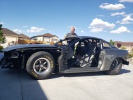
Originally Posted by
crakrz

Mine is the earlier Bosch ECU, not the E98, but the same turbo and intercooler. It can easily maintain 300kpa (30psi boost) past 3200 rpm. It's just not very efficient at that point. The turbo is turning really hard by that stage. Measuring air flow at the maf, they really struggle to push more air by the time you reach 3500 rpm. No matter how much boost you are getting at the manifold, it just can't push enough cool air in to keep egt's down. I have found the efficiency range of this turbo is 1500 - 3000rpm, which is absolutely perfect for this motor and the real world conditions, but the limitations really show once you start going outside that range. It will go higher, but everything just starts heating up pretty fast.




 Reply With Quote
Reply With Quote
